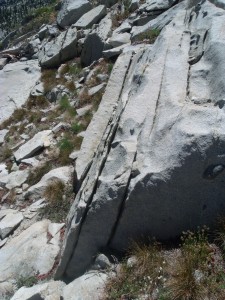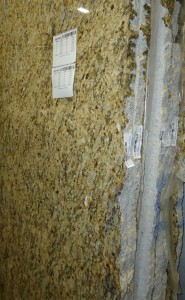I recently returned from a camping trip in Northern California’s
Trinity Alps and was awestruck by the natural beauty of these lands
located north of Weaverville and southwest of sprawling, ominous Mt.
Shasta. As I hiked up the cliffs overlooking the aptly named Granite
Lake, it struck me that the natural forces of the earth could produce
such a magnificent material and that human hands and ingenuity could
refine it into such an attractive yet practical product like a kitchen
countertop.
After the hike, while floating on the lake with a cold beer, I
wondered what, if anything, could be produced from the type of granite
that surrounded me. Weaverville and the other small communities in the
vicinity were born as mining towns during the gold rush, but many other
mineral deposits could also be found.

On the drive in, down Highway 3, it was apparent that crushed rock
and gravel were dominant. Piles of rocks more than 100 ft. high
stretched along the road for miles at a time, and after a short break,
there continued several miles more of nothing but quarried, crushed
rock.
Upon reflection, I noted the natural formations on the cliffs were
mostly cracked and broken. And although some large veins of pure quartz
sparkled fantastically in the sunlight, the granite was somewhat dull
and less than lustrous. When I returned home, I put my research machine
into action, and discovered that my hunch was correct. The granite
deposits in the Trinity Alps had experienced tremendous pressure during
their formation, and the compression made them unsuitable for use as
dimension stone. So, if U.S. granite doesn’t come from here, then from
where do we get our slabs?
The United States mines an exceptional amount of dimension granite
and other dimension stone. In fact, this country is one of the leading
producers of natural stone in the world, but this only makes it more
shocking that our dimension stone imports average at about 80 percent of
our consumption.
According to the 2014 report from the U.S. Geological Survey (USGS),
2.17 million tons of U.S. dimension stone valued at $460 million was
sold or used in the U.S. in 2013. A total of 208 companies produced the
stone from 276 quarries in 34 states, and the leading producers were
Texas, Indiana and Wisconsin. In addition, the tonnage of dimension
stone produced has been increasing each year since at least 2009, when
the total was 1.62 million.

Although these numbers seem promising and look good without any
comparisons, the $460 million of dimension stone used or sold by U.S.
producers is dwarfed by the $1.86 billion in dimension stone imports.
Of the total dimension stone sold or used by U.S. producers in 2013,
41 percent was limestone, 23 percent granite, 15 percent sandstone, 3
percent marble, 2 percent slate and 15 percent miscellaneous. By value,
50 percent of this stone was dressed, and 46 percent of dressed stone
was sold in partially squared pieces or slabs.
Looking more specifically at granite, 500,000 tons was produced in
the U.S. by 39 companies operating 57 quarries in 15 states, and 80
percent of that was exported. The rest of the granite used in the U.S.
was imported from Brazil (42 percent), China (23 percent), India (14
percent) and Italy (13 percent). Even with a median tariff of 3 percent
on dimension stone, it still somehow makes more sense to go with the
imports rather than with domestically produced stone.
Many environmentalists in the U.S. would agree that this country
should be spared from increased mining, which could disrupt natural
ecosystems and become an eyesore on the landscape. However, the
environmental impact of transporting these slabs from halfway around the
world could, arguably, be causing much more damage.
In addition, some reports have stated that some overseas granite
operations are funding terrorism, and the granite coming from China is
of inferior quality and cannot be used domestically.
So, what is it that makes granite imports so popular?
The leading factor, of course, is price, and following close behind
is the fact that we do not have the infrastructure in place to meet such
high demand. The United States is the world’s top market for dimension
stone. Since the economy recovered, demand for dimension stone has
increased not only for construction but also for use in existing
structures.
Some people say that U.S. granite just doesn’t exhibit the vibrant
and unique color patterns of imported stone, but is this truly the case?
While certain colors and patterns are unique to locations overseas, it
seems that the United States has slabs of equal or even greater
brilliance.
Kurt Swenson, president of one of the largest granite quarries in the
U.S., Rock of Ages in Vermont, says that much of the demand for
overseas granite is black granite. However, some of this demand is for
block granite or decorative granite that is to be etched, which is not
typically done on slabs for countertops.
Chuck Monson, president of Dakota Granite, is in agreement with
Swenson. He states that the demand for black granite rose when the U.S.
decided to use such slabs imported from India to build the Vietnam
Memorial. But again, he was referring to granite to be used for
monuments and statues rather than countertops.
So, is it simply price that is driving the market for imports? Many
U.S. granite producers think so. However, another factor may simply be
ignorance by the average consumer. Perhaps an education campaign can
bring U.S. production up and help to further stimulate our economy.
If you have any thoughts, questions or answers to those posed here, please post a response.

